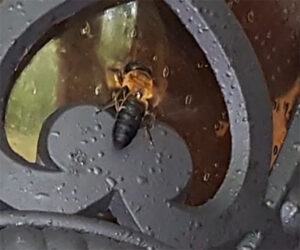SCULPTURED OR GIANT RESIN BEE
Summertime is here, and that means that bees are active in the Canton, GA, community. Today’s focus will be on a newcomer to our area, and that is the sculptured (giant) resin bee. This native of Japan and China is actually an invasive species and could prove to be a problem for the local carpenter bees as well as causing other issues. North Carolina was the first US state to confirm sightings of the resin bee in 1994.
The good news is that the resin bee is not particularly aggressive towards humans and eats kudzu. If you’re unfamiliar with kudzu, let me start by saying it is a complete menace. In fact, its nickname is “the vine that ate the South,’’ and the title is well deserved. Not surprisingly, kudzu is also invasive and originated in Japan, China, and surrounding areas. So naturally, the resin bee is quite happy with the food offerings of Georgia.
Unfortunately, the carpenter bees are not so excited by the newbies in town. The sculptured resin bee is unable to bore its own holes because the mandible strength is not great; however, they are happy to take over the holes created by the carpenter bees. The holes are created by the carpenter bees in order to lay eggs and make their nests, so the carpenter bee population can be greatly reduced if the resin bees take over their nesting areas and claim them as their own. This is bad news for the carpenter bees. It has been reported by some that the resin bees also attack honey bees, and honey bees definitely have enough problems without another enemy.
It can be difficult for most of us to identify different varieties of bees, but it is important to try to distinguish between the resin and the carpenter bee. The sizes are similar; however, they are dissimilar in appearance. The resin bee has striations in its abdominal areas. These striations have raised bands. Females have an abdomen that is pointed, while the male has a rather blunt edge to his abdominal area. In contrast, the carpenter bee has a thorax and abdomen that are connected and which are smooth and bald in appearance. It’s a bit funny, but a good way to remember the difference is that a carpenter bee has a shiny backside. It’s true.
Now maybe like me, you are wondering why it’s a big deal to lose the carpenter bee and why a bee that doesn’t sting me but does eat kudzu is negative. Let’s explore that question. First of all, carpenter bees are excellent pollinators. It is thought that 15% of our agricultural crops are pollinated by our native bees. And let’s face it, food is majorly important for our survival. No bees, fewer crops. And here is a disappointing fact. The kudzu that is eaten by the resin bee is not the positive trait I first thought of. The resin bee does in fact pollinate, and guess what it is the best pollinator for? Kudzu! The giant resin bee is spreading one of the worst invasive plant species the South has ever known! Bad, bad, bad. For many reasons, we need to be alert to the presence of the giant resin bee.
Any observations of this invader can be reported to The University of Georgia, which does a Georgia Pollinator Census each year.
As always, if Canton Termite and Pest Control can help you with any pests bugging you, give us a call at 770-479-1598
By: Robin
